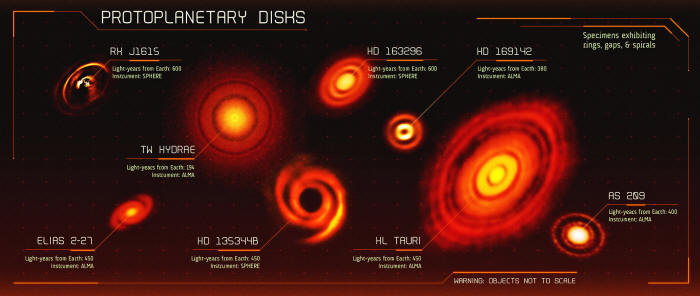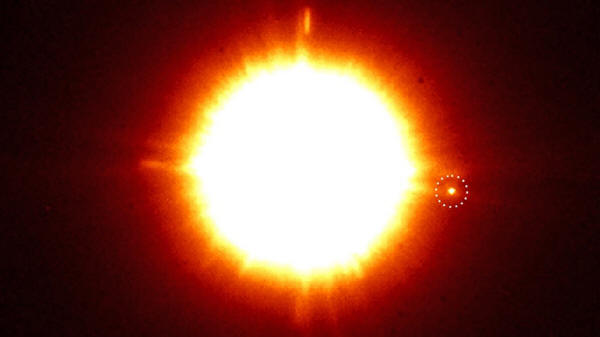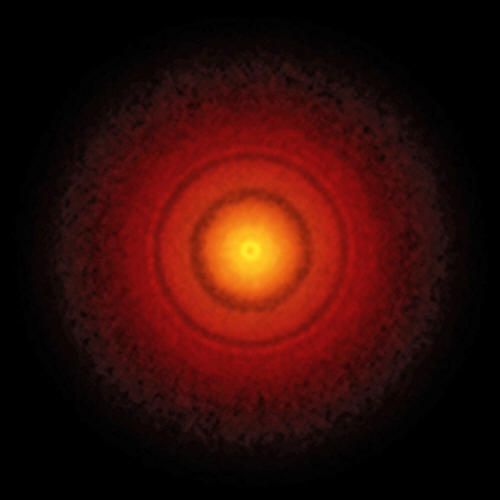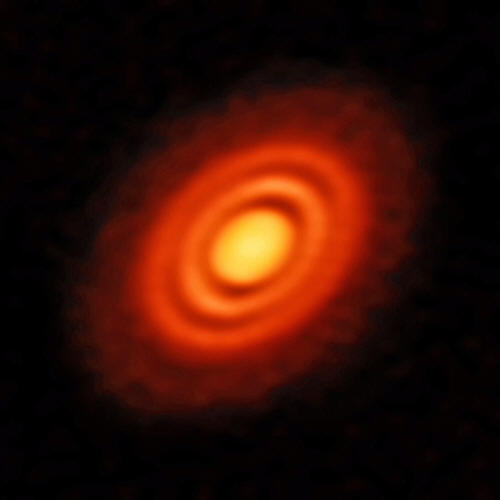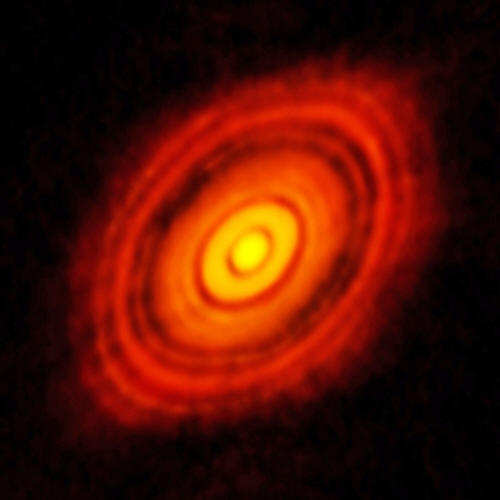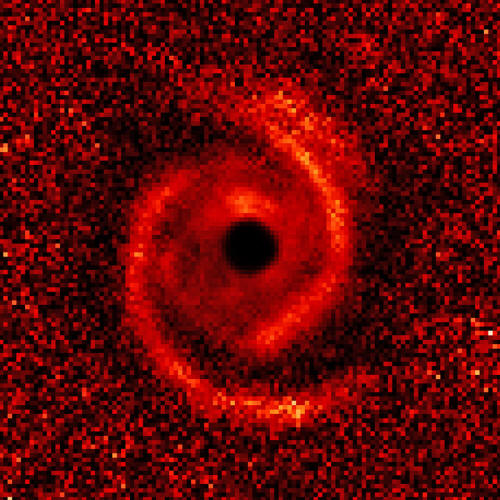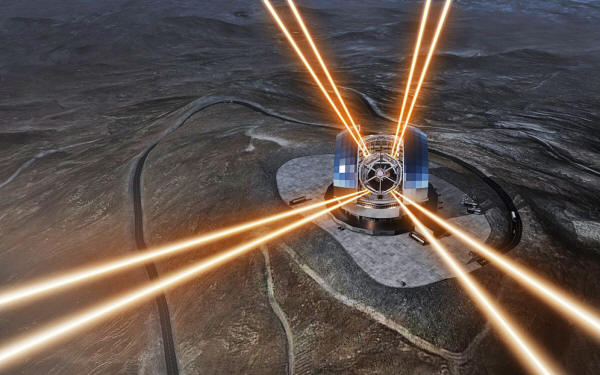|
Adapted by Olena Shmahalo
Quanta
Magazine swirling around young stars show the details of how solar systems come to be.
But as for testing the idea, by actually spotting an exoplanet coalesce from swirling matter?
No luck yet...
Advances over the past few years suggest it won't stay theoretical for long.
Using second-generation instruments mounted on giant ground-based telescopes, several teams have finally resolved the inner regions of a few protoplanetary disks, uncovering unexpected, enigmatic patterns.
The latest views came on April 11, when the European Southern Observatory (ESO) released eight images of disks around young, sunlike stars, perhaps illustrating what our own solar system looked like in its infancy.
The images don't show clear, unambiguous points of lights from planets. But these and other systems do contain tantalizing - albeit indirect - hints that infant planets may be hiding within.
Some disks are like a vinyl record, with rings and gaps that could have been carved out by young worlds. In others, starlight illuminates both a top and bottom surface of the disk, forming a structure that resembles a yo-yo.
If astronomers could find an embryonic planet in a place like this, the payoff would be far-reaching.
Beyond just proving one of astronomy's deepest-held ideas, the quantitative measurement of where a planet is forming, and at what size, would immediately help differentiate between battling theories of how planets are born.
One account of planet formation, called core accretion, holds that planets form slowly, coalescing around rocky cores, and in a region close to their stars. Another theory appeals to gravitational instabilities in the disk, suggesting giant planets can coalesce quickly, far away from their stars.
Currently, these ideas can be tested against the distribution of current planets in our solar system and extrasolar systems.
But they've never been studied with the process still under way, before planets have a chance to migrate and rearrange themselves. That gives astronomers who study these systems a unifying, unfinished quest. Look at dim, distant, untidy disks. Hunt down baby planets.
And at long last, after centuries of anticipation, begin to unravel the fundamental processes that shape countless worlds across the universe.
Direct Detection
When searching for planets in protoplanetary disks, it's easy to convince yourself that you're seeing them.
Astronomers who study these disks have already spotted multiple specks of light hiding inside.
As recently as May 06, for example, an international team reported signs of a giant planet lurking in a system called CS Cha. (First direct detection of a polarized companion outside of a resolved circumbinary disk around CS Cha).
But for now these specks remain mere planetary candidates, not confirmed worlds.
The CS Cha system hides what appears to be a small companion, highlighted here in the dotted circle. Special polarization filters (blue image)
reveal a dust disk in addition to the hidden object.
This ambiguity is intimately tied to the same messy environments that would make these planets special.
One instrument leading the search is SPHERE, mounted on the Very Large Telescope (VLT) in Chile's Atacama Desert, which obtained the eight recent protoplanetary disk images.
Another, which Katherine Follette works on, is the Gemini Planet Imager (GPI), a rival instrument on another Chilean mountain.
The disk surrounding TW Hydrae
has rings that could reveal hidden planets. B. Saxton (NRAO/AUI/NSF) ALMA (ESO/NAOJ/NRAO)
Both were designed to catch photons from planets around other stars, unlike most techniques for studying exoplanets that rely on more indirect signatures.
Both also produce data that's easiest to interpret when they're trained on uncluttered, older solar systems where disks have already eroded.
These cameras need ways to peel faint pinpricks of light away from bright host stars, like finding a firefly sitting on the rim of a distant spotlight. They use adaptive optics, a technology that tracks fluctuations in the atmosphere and then warps its own optics in real time to compensate.
This cancels out Earth's roiling air, de-twinkling the night sky to achieve higher resolution. They also use coronagraphs, which block out light from the star.
And on top of that, these planet-hunting cameras employ yet another trick called differential imaging. SPHERE, for example, takes two simultaneous pictures through different polarized filters.
Starlight itself isn't polarized, so the star looks the same in both versions.
It can be subtracted away. But when light scatters, it gets polarized. This allows astronomers to accentuate the photons that have bounced off a disk or a planet.
Algorithms then search for leftover points of light.
But when looking for planets within disks, the algorithms can confuse clumps and clouds for newborn worlds.
The concentric rings surrounding the young star HD 163296 are likely caused by Saturn-mass planets
that clear out regions of gas and dust. A. Isella; B. Saxton (NRAO/AUI/NSF)
Follette and colleagues have spent the past few years trying to analyze these false signals.
They've also studied puzzling planet candidates (An Optical/near-infrared investigation of HD 100546 b with the Gemini Planet Imager and MagAO), including some that don't seem to be orbiting their host star in accordance with Kepler's laws of motion, as all planets would.
Meanwhile, there's another path to planets unfolding in parallel.
Although SPHERE and GPI haven't unambiguously found a forming world, they have managed to take the sharpest-ever pictures of protoplanetary disks themselves.
Finally seen up close, these disks host a menagerie of strange features that may be linked to planet formation.
The problem lies in associating these features with the putative planets causing them.
And that's not easy, either.
Spiral Cradles
Consider a striking pattern first noticed in 2012.
In at least half a dozen protoplanetary disks, something seems be winding gas and dust into seashell whorls like the arms of spiral galaxies.
The protoplanetary disk surrounding the young star HL Tauri has multiple concentric rings. Astronomers believe that newly formed planets
are carving out the complex structure.
Astrophysicists have two main ideas to explain what's making these spiral arms.
Both borrow from a decades-old theory of galactic spirals. According to this idea, gas and dust spinning around a newborn star begin to pile up in a celestial traffic jam.
Something has to trigger the initial snarl-up, however.
Astronomers have suggested that in stars surrounded by heavy disks - those that weigh at least a quarter as much as the star they orbit - gravitational instabilities can cause pileups of material into spiral arms.
But researchers have found many spiral disks that appear to be far below this mass threshold, intimating that another mechanism may be at work.
Perhaps a hidden puppeteer is to blame...
In 2015, a team led by Ruobing Dong, the Arizona astrophysicist, built simulations that showed how giant planets a little bigger than Jupiter could trigger spiral whorls, too.
The planet would sit right at the tip of one the arms and drag the spiral along as it orbited the star. If this is the case, every spiral is like a giant arrow pointing toward the field's ultimate quarry - a planet in the process of being born.
In 2016, Dong's team found evidence that these spirals can be triggered by a massive body. In this case, the triggering object orbiting the star HD 100453 was a dwarf star, which is easier to spot than a planet.
But it served as a proof of concept.
Finding an arm-tip planet itself would seal the deal, but astronomers are still waiting.
In a recent paper (A Decade of MWC 758 Disk Images - Where Are the Spiral-arm-driving Planets?) in The Astrophysical Journal Letters, a team led by Bin Ren, a researcher at Johns Hopkins University, gathered and analyzed data from MWC 758's spiral going back more than a decade.
The spiral arms surrounding the star MWC 758
could have been sculpted by a giant planet out by the tip of one of
the arms. (University of Grenoble), R. Dong (Lawrence Berkeley National Laboratory) Z. Zhu (Princeton University)
Over this time, Ren's analysis shows, the whorls may have rotated ever so slightly, at about six tenths of a degree per year.
This rotation would be expected from a giant planet out at the tip of an arm that orbits the star every 600 years or so, Ren said. But such a planet, if it exists, is still hiding.
Of course, even if spirals are conclusively linked to planets, they won't lead the way to all newborn worlds.
In simulations, only gas giant planets are hefty enough to draw spiral patterns. Smaller worlds would have to be discovered through other means. And not all protoplanetary disks host spirals, either.
For example, none of the new SPHERE images of disks around sunlike stars have spiral arms.
(That suggests the spiral process, whatever it is, may be more efficient around more massive stars, said Henning Avenhaus of the Max Planck Institute for Astronomy in Heidelberg.)
But they and many other protoplanetary disks do show something else, something perhaps even more promising:
Planets in the Cracks
In the fall of 2014, astronomers testing ALMA, a collection of radio dishes in the Chilean Andes, decided to train it on the most massive protoplanetary disk they could find.
When the resulting picture of empty gaps and thick rings in a system called HL Tauri was later displayed at an internal ALMA meeting, it stopped the show.
Looking at the gaps, the assembled scientists debated whether they were produced by planets.
ALMA scientists later studied images of another, nearby system called TW Hydrae, which show similar gaps in even higher detail.
But neither system can settle the issue of whether the gaps are caused by planets or by something else.
The ALMA observatory's 66 antennas search the skies above the Chajnantor plateau
in the Chilean Andes.
Just like spirals, both planets and other effects can sculpt gaps.
A planet would carve out a gap over thousands to millions of years. As it orbits, it would both pull disk material in toward itself as well as scatter it away from the planet's orbit, leaving an empty groove.
This gravitational engraving would be cumulative.
While it takes something bigger than Jupiter to make a spiral, worlds the size of Neptune or even as small as Earth could create noticeable gaps, said Jeffrey Fung, an astrophysicist at the University of California, Berkeley.
Crucially, these gaps might be the only near-term chance to study the formation of small planets, which would be even more difficult than Jupiter-size worlds to spot directly in a disk.
What might be making these gaps if not planets?
The magnetic field of a disk can lead to regions of turbulence, sweeping material away from what become empty, magnetic "dead zones." Or abrupt changes in chemistry can cause a gap that also mimics the action of a planet.
A solar system's snow line, for example, marks the boundary between the hot inner disk, where water exists as vapor, and the outer disk, where water freezes into solid grains.
Similar transitions occur for other compounds, like carbon monoxide and ammonia.
The confusion leaves astronomers searching for an answer key.
Technically, current technology would not pick up a planet itself, but a smaller, circumplanetary disk of material falling onto one.
If such a signal could be linked to a spiral or gap, it would help observers start translating back and forth between worlds and disk features more generally.
The wait might not be too long.
Next-generation telescopes should also be able to help.
The James Webb Space Telescope (JWST) will be able to peer inside disks in infrared wavelengths and look directly for planets.
Its launch has recently been delayed again, this time to 2020...
The Extremely Large Telescope, currently under construction in Chile, will use lasers to create artificial stars high in the atmosphere, allowing researchers
to "de-twinkle" the sky.
And the challenge of catching planet formation in the act is "a beautiful science case" for 30-meter-class telescopes, said Bruce Macintosh of Stanford University, who leads the GPI team.
Observatories that size, like the Extremely Large Telescope (ELT) currently being constructed in Chile, will be able to resolve even smaller structures inside protoplanetary disks.
Whenever it happens, confirmed cases of forming planets will be "groundbreaking," Dong said.
What used to be a mathematical bedtime story of the birth of worlds would be playing out in real time, in real data.
|


